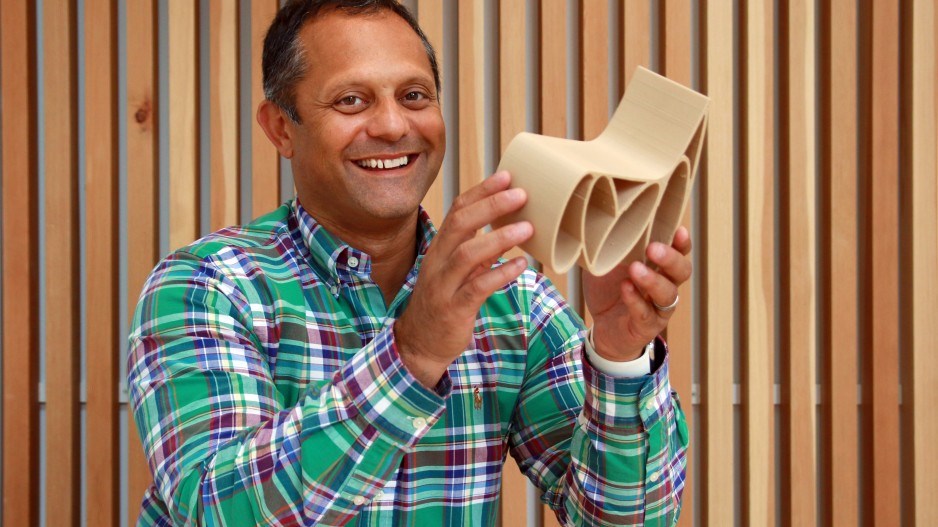Neil Patel is adamant that, in the next decade, 3D printers will become as common a household item as a personal computer.
“It just makes no sense [that] the world’s biggest industrial secret that’s been around 30 years won’t be unleashed on the world population – because anyone can design and literally produce this at home,” he said, gesturing to a neon-green basket the size of a dinner plate and height of a coffee mug.
“I just can’t see why that isn’t going to become part of life.”
As CEO of Vancouver-based Print the Future, Patel – and, incidentally, corporate giants such as Hewlett-Packard (NYSE:HPQ) – is banking on his prediction.
Gone are the days when 3D printing was merely about multithousand-dollar machines making trinkets or prototypes out of resin. Staples Inc. (Nasdaq: SPLS) now sells a 3D printer for under $300. Higher-end machines can make goods out of stainless steel, chocolate, wood and more than 100 other materials.
Machines can make machines, prosthetics and food. Costs have come down, and options have increased to the point where Patel foresees the day when a customer can walk into one of his stores, tell a computer the type of chair he or she wants to buy, choose from the options closest to his or her tastes and preferences and send the order straight to a 3D printer. In a couple of hours, six identical garden chairs at Ikea prices are ready for pickup in time for the customer’s dinner party.
“For me, 3D printing is where BlackBerry (TSX:BB) was 10 years ago,” Patel said. “Jump forward now almost 10 years, we’ve got smartphones, we’ve got the Apple (Nasdaq:AAPL) store, we’ve got Android, and we’ve got apps that we use in our daily lives. Really, we’re immersed in our smartphone.”
At Kabuni House on West Pender, west of Thurlow, Patel is getting ready to create the first Print the Future store, outfitted with printers, materials and room for 3D-printing boot camps.
Each workshop, he said, will be designed to arm parents, teachers, children, nerds and hobbyists with the skills to use 3D-printing technology, unfamiliarity with which remains a barrier to 3D printing going mainstream.
“Having a 3D printer nowadays is a bit like having a personal computer in the late ’70s. They are very hard to operate, it’s very temperamental, you need to be a technician to have one,” said Thierry Rayna, an economist and professor of innovation management at the Novancia Business School Paris.
“Can the technology evolve and become good enough that people could have a printer at home? The answer is yes – yes, definitely. Now the question is, for that to happen, you sort of need to find a purpose, and at the moment, that’s the big problem with 3D printing.”
For companies like 3DSmith in downtown Vancouver, that purpose is niche customization.
Brothers Steve and Chris Choi have built a full-time business by offering 3D-printed products in the form of medical prototypes, film set props, personalized gifts and odd requests, like one to recreate a missing plastic part from a collapsible canvas tent.
“Where the whole money-saving thing is really evident is when people are doing prototyping for innovative products, for instance, or they’re doing architectural models, jewelry work, a lot of things where it normally takes professionals to build, where a lot of skill sets are needed,” said Chris Choi.
While it’s an area that’s proving successful for the Choi brothers – they have around 10 companies regularly making orders and their printers are often whirring and layering throughout the night – Rayna doesn’t see customization for the sake of customization pushing 3D printing into the mainstream.
“Give it five, 10 years, every single company will offer you to customize stuff. I mean, how much time can you spend customizing stuff?” he said.
If you can collect data, Rayna added, having products customized for you is a much more compelling, and marketable, idea.
At Print the Future, Patel is looking at what Rayna calls crowd customization – a model in which a pool of global designers would produce digital plans for structurally sound and well-designed products that would be printed at a local store.
If that’s the future, intellectual property rights and laws will be at the centre of an industry where anyone can be a designer. Getting costs down will also be an issue.
Patel said that for more $2,500, his company printed a stainless steel door handle for a customer who would otherwise have had to wait five months. Rayna noted that even with rapid prototyping, an area where 3D printing has had some success, printing locally isn’t always the most economically viable method.
“It’s very often cheaper to send your CAD [computer-aided design] file to China and have the prototype manufactured there. Which, if you think about it, doesn’t make any sense at all,” he said.
Print the Future is trying to close its first round of funding, and Patel is looking to secure US$25 million before listing on Nasdaq, which he hopes to do by the end of the year. He foresees opening a new store every quarter in 2018, starting in New York.
His end goal of launching the world’s first retail chain of 3D-printing locations is ambitious, but he said the time is right.
“We’re at a point where there are enough companies, enough materials, enough printers and enough investments that’s gone into 3D printing, that the timing’s now.”•




